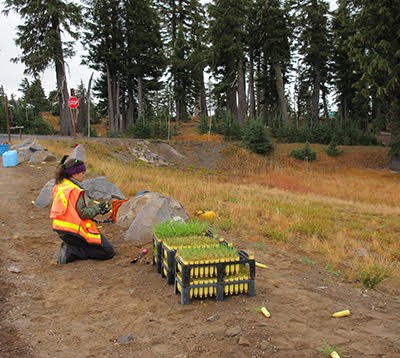|
There are two sides to disturbed lands restoration. One is the coordinated effort that staff botanists and volunteers dedicate to restoring an area that has suffered significant damage. The flip side to these efforts is why does damage occur and what effect does it have on the environment. 
DisturbancesWhile Crater Lake National Park is protected federal land, it is not immune to human-caused disturbance. Impacts from activities such as road construction and infrastructure improvements create large barren areas. Before construction begins, native seeds are collected and plants propagated in the hopes to reseed and replant disturbed areas when the construction is complete.Enthusiastic visitors often don’t realize their own impact on a landscape when they go off trail to take a photo or have a picnic in a meadow. Vehicles pulling off the side of the road destroy many plants. The biggest impact from visitors is the creation of social trails—unofficial paths that occur when person after person walks or hikes through an area, potentially killing vegetation and leaving an un-maintained trail. 
RestorationSince 2013 the Ecological Restoration program has been protecting the Park’s native plant communities through restoration of disturbed sites. Restoration efforts include creating revegetation plans; collecting native seed; and drying, cleaning, and storing native seed.Restoration efforts also include propagating plants for restoration outplantings; caring for propagated plants in the park’s native plant nursery; creating and using park-sourced compost to add organic matter to disturbed soils; broadcast-seeding disturbed areas with native seed; and outplanting propagated and salvaged plants into disturbed habitats for restoration. 
NPS Photo Goals of the Ecological Restoration Program:
|
Last updated: June 23, 2019
